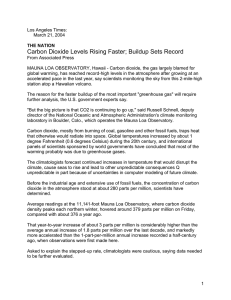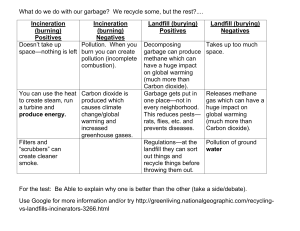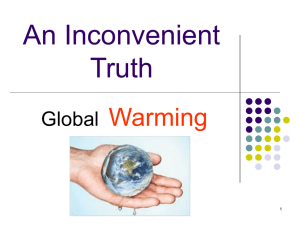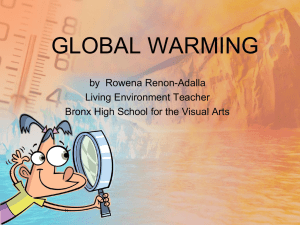Greenhouse_gas_science_reading_qs
advertisement
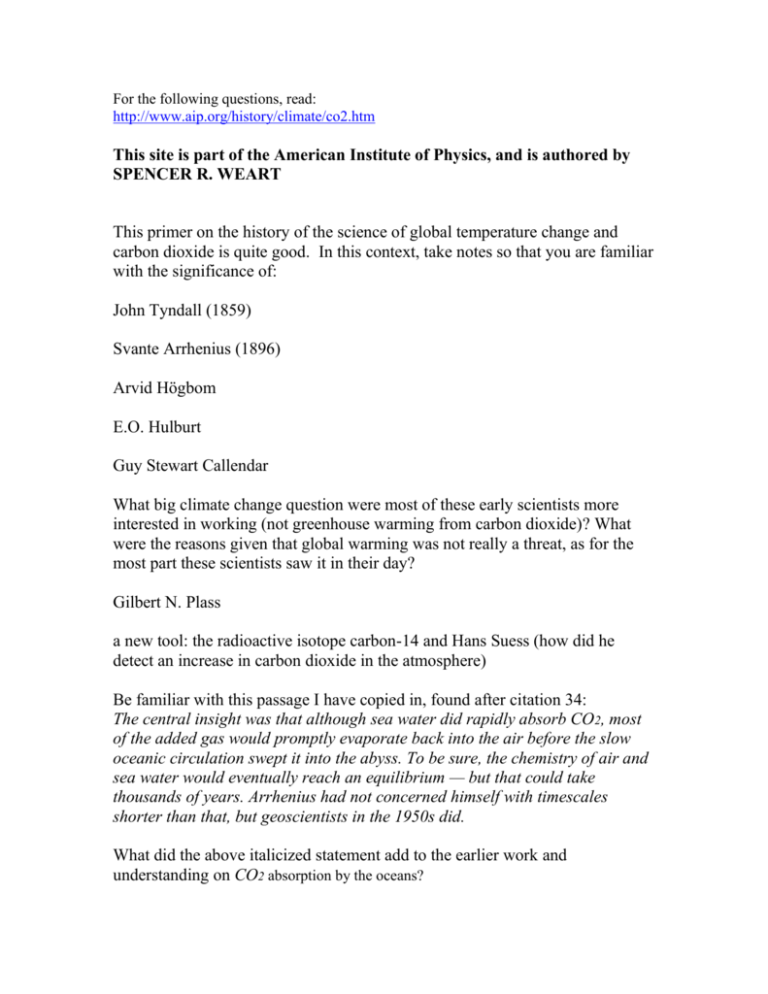
For the following questions, read: http://www.aip.org/history/climate/co2.htm This site is part of the American Institute of Physics, and is authored by SPENCER R. WEART This primer on the history of the science of global temperature change and carbon dioxide is quite good. In this context, take notes so that you are familiar with the significance of: John Tyndall (1859) Svante Arrhenius (1896) Arvid Högbom E.O. Hulburt Guy Stewart Callendar What big climate change question were most of these early scientists more interested in working (not greenhouse warming from carbon dioxide)? What were the reasons given that global warming was not really a threat, as for the most part these scientists saw it in their day? Gilbert N. Plass a new tool: the radioactive isotope carbon-14 and Hans Suess (how did he detect an increase in carbon dioxide in the atmosphere) Be familiar with this passage I have copied in, found after citation 34: The central insight was that although sea water did rapidly absorb CO 2, most of the added gas would promptly evaporate back into the air before the slow oceanic circulation swept it into the abyss. To be sure, the chemistry of air and sea water would eventually reach an equilibrium — but that could take thousands of years. Arrhenius had not concerned himself with timescales shorter than that, but geoscientists in the 1950s did. What did the above italicized statement add to the earlier work and understanding on CO2 absorption by the oceans? Where did David Keeling work, and what did he find? What is Keeling's Curve? What did Helmut Landsberg stress in a 1970 review? What was meant by the statement made in the 1970s that some of the carbon was "missing"? What do the ice cores tell us about the long term relationship between carbon dioxide concentrations and temperatures? How far back did these cores go in the case of the mid-1980s research? Later the proposition is made that solar luminosity was less billions of years ago than it is now. This would make for a much colder Earth than now, and yet at times it was warmer. Why? (include how carbon dioxide concentrations are modified by chemical weathering of Earth's surface, and volcanoes) How is it hypothesized that Earth was able to escape from it's snowball episode? The Vostok cores go back how far? What is the highest carbon dioxide concentration they show? What is the current atmospheric concentration? Is this notable, in your opinion? What was surprising and confusing to people in the first part of the section that begins with Time Lags and Feedbacks (1990s)? How was this explained? Is the explanation given above good news or not? Explain. The new ice cores suggested that a powerful feedback amplified the changes in sunlight. "The crucial fact was that a slight warming would cause the level of greenhouse gases to _____ _______". What are Milankovitch cycles? How do they interact with carbon dioxide and temperature? What would the vast Arctic bogs do with emissions when they warm up? A final nail in the coffin of scientific skepticism came in 2005. Explain. (found near note 56) (be sure to note the significance in the statement near the end of the paragraph: "Warming from other sources, for example a change in the Sun's output, could not produce these patterns". What do ancient fossil leaves add to scientific understanding of historic carbon dioxide changes? The above questions illustrate how scientific theory is built. The more corroborative the evidence is that comes in from a variety of different fields (paleontology, atmospheric physics, geology, plant physiology, oceanography, to name a few) the stronger the theory becomes. In other words, evidence from a variety of different branches of science gives strong support to the theory that carbon dioxide and temperature are connected in a cause and effect relationship. What is alarming about studies from 2010 about eras in the distant past when CO2 levels had been high? Have the climate models accounted for these slow positive feedback loop effects? Why is this important? It is written after note 57a that Individual climate scientists, while almost unanimously in agreement with the consensus in its broad outlines, continued to argue vehemently over details, as always in frontier research. Critics pounced on every apparent discrepancy. Why is this important, and how might the public perceive this (especially the part of the public that doesn't understand how science works)? Where was most of the missing carbon mentioned earlier actually found? Summarize the paragraph that contains note 61. What was the "frightening experience" of many scientists? -----------------------------------------------------I have little doubt that most of you are by now feeling overwhelmed by this. It's complex, isn't it. This is one of the reasons that society has trouble dealing with the issue. Global warming science strongly suggests that humans need to make big changes in the energy systems that we have come to rely on. But the science is so complex that most people will never have much understanding of it at all, and are likely to fall back on what they recently heard their local meteorologist say, and that could be that the last few winters have been colder than normal. (many meteorologists are notoriously local in their perspectives) Combine that with a media system that includes obviously biased sources, together with other outlets that want to be fair and so present climate change science as if there were a big debate with roughly an equal number of specialists on both sides. (Clearly this is not the case.) So I hope that by now it is becoming a little more clear why the title of the course is Energy, Environment, and Society. Discuss to what degree the general public will ever understand the material that has been covered in this reader. Does it need to understand in order for society to take sufficient action?

